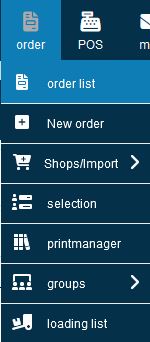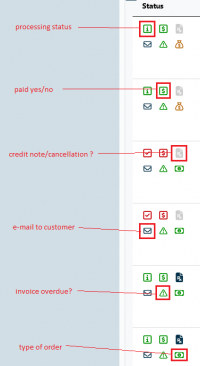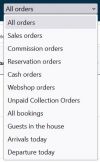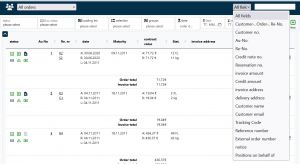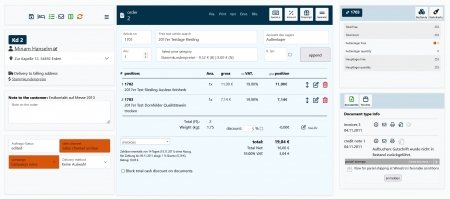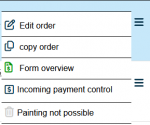En:Order list: Difference between revisions
No edit summary |
|||
| (7 intermediate revisions by the same user not shown) | |||
| Line 1: | Line 1: | ||
[[Datei:Order list.JPG|150px|thumb|right|how to find the order list]] | |||
All orders entered in Winestro.Cloud are displayed in a common order list, which can be filtered and sorted according to certain criteria. In this article, we will show you how to work with the filter functions and quickly and easily display the desired orders or search for specific orders. | |||
[[Datei:Order list.JPG| | |||
== Structure of the order list == | == Structure of the order list == | ||
| Line 14: | Line 12: | ||
'''1. Symbol: Processing status.''' | '''1. Symbol: Processing status.''' | ||
This symbol indicates whether an order is unprocessed, being processed or has already been processed. If you click on the icon once, it changes its colour and thus its status. A '''red icon''' means that the order has not yet been processed. A '''yellow symbol''' indicates that the order is currently being processed. A '''green symbol''' indicates that the order has already been processed. Most users allow the programme to change this status automatically. In this case, the order is automatically set to processed as soon as an invoice has been written for the order (more on this under [[ | This symbol indicates whether an order is unprocessed, being processed or has already been processed. If you click on the icon once, it changes its colour and thus its status. A '''red icon''' means that the order has not yet been processed. A '''yellow symbol''' indicates that the order is currently being processed. A '''green symbol''' indicates that the order has already been processed. Most users allow the programme to change this status automatically. In this case, the order is automatically set to processed as soon as an invoice has been written for the order (more on this under [[en:Order list|Orders]]). | ||
'''2. Symbol: Has the order already been paid for?''' | '''2. Symbol: Has the order already been paid for?''' | ||
The second symbol indicates whether the order has already been paid for or not. Accordingly, the '''$ symbol is red or green'''. Clicking on the symbol opens the [[ | The second symbol indicates whether the order has already been paid for or not. Accordingly, the '''$ symbol is red or green'''. Clicking on the symbol opens the [[en:Payment control]] for this order. | ||
'''3rd symbol: Is there a [[ | '''3rd symbol: Is there a [[en:Documents for an order#Credit notes| Credit note]] or a [[En:Documents for an order#Cancellation document / charge reduction| Cancellation]] for this order? ''' | ||
Depending on whether the icon is '''blue''' or '''greyed out''', the system displays whether or not a '''credit memo''' or a '''cancellation document''' has been created for the order. | Depending on whether the icon is '''blue''' or '''greyed out''', the system displays whether or not a '''credit memo''' or a '''cancellation document''' has been created for the order. | ||
| Line 37: | Line 35: | ||
Open and unpaid orders have an effect on the programme. | Open and unpaid orders have an effect on the programme. | ||
If an order is still unpaid, no payment has been received and it remains marked as unpaid until a payment has been received. If the status remains unchanged, the orders can be reminded, which is directly recognisable by the symbols. If several reminders are to be sent at once, all orders to be reminded can be selected via [[Selektion | If an order is still unpaid, no payment has been received and it remains marked as unpaid until a payment has been received. If the status remains unchanged, the orders can be reminded, which is directly recognisable by the symbols. If several reminders are to be sent at once, all orders to be reminded can be selected via [[Selektion| Order selection]] so that several reminders can be sent simultaneously with one click. | ||
=== Quick information about the order === | === Quick information about the order === | ||
| Line 73: | Line 71: | ||
invoice, delivery, credit note or commission date. To do this, specify the start and end date of the period within which you are searching for the order as precisely as possible. | invoice, delivery, credit note or commission date. To do this, specify the start and end date of the period within which you are searching for the order as precisely as possible. | ||
You can also restrict the order list to a specific [[ | You can also restrict the order list to a specific [[en:Loading lists|loading list]] of a wine tour or a [[Selektion#Auftragsselektion | order selection]] that you have already created. | ||
Note: There are small grey arrows next to each column heading, which you can use to sort the orders in ascending or descending order according to various criteria, e.g. date, invoice number or order number. | Note: There are small grey arrows next to each column heading, which you can use to sort the orders in ascending or descending order according to various criteria, e.g. date, invoice number or order number. | ||
| Line 112: | Line 110: | ||
The DTA export can output this information collectively in a SEPA direct debit file or an XML format so that this can be imported into your banking programme. | The DTA export can output this information collectively in a SEPA direct debit file or an XML format so that this can be imported into your banking programme. | ||
== | == explanation video == | ||
We have also created a video for this Wiki article that explains the order list clearly. | |||
<embedvideo service="youtube" dimensions="350" >https://www.youtube.com/watch?v=yE5DL-ICX7Q</embedvideo> | |||
Latest revision as of 09:58, 17 October 2024
All orders entered in Winestro.Cloud are displayed in a common order list, which can be filtered and sorted according to certain criteria. In this article, we will show you how to work with the filter functions and quickly and easily display the desired orders or search for specific orders.
Structure of the order list
You can access the overview of the order list via Order - Order list. All the orders you have created can be displayed there. In addition to the orders themselves, you can see a lot of important information about the individual orders at a glance, which is explained in the graphic on the right and in the rest of the article.
Status
Next to the individual commands, various icons can be seen on the far left, which provide a lot of information at a glance. The meaning of the individual symbols is explained below. We will work our way from left to right.
1. Symbol: Processing status. This symbol indicates whether an order is unprocessed, being processed or has already been processed. If you click on the icon once, it changes its colour and thus its status. A red icon means that the order has not yet been processed. A yellow symbol indicates that the order is currently being processed. A green symbol indicates that the order has already been processed. Most users allow the programme to change this status automatically. In this case, the order is automatically set to processed as soon as an invoice has been written for the order (more on this under Orders).
2. Symbol: Has the order already been paid for? The second symbol indicates whether the order has already been paid for or not. Accordingly, the $ symbol is red or green. Clicking on the symbol opens the en:Payment control for this order.
3rd symbol: Is there a Credit note or a Cancellation for this order? Depending on whether the icon is blue or greyed out, the system displays whether or not a credit memo or a cancellation document has been created for the order.
4. symbol: Send e-mail to the customer If an invoice has already been created and not yet sent to the customer by e-mail, the colour of the icon is orange. By clicking on the icon, you can now write an e-mail to the customer and send the invoice. If one has been created - the invoice is automatically attached to the e-mail. If the symbol is ‘’‘blue’‘’, you can send the customer an e-mail with one click, but an invoice cannot and will not be attached here. A green letter indicates that the invoice has already been sent to the customer by e-mail. The red mail symbol indicates that the customer does not have an e-mail address on file.
5th symbol: Invoice overdue? Depending on whether the symbol is green or red, it is displayed whether the payment term has already been exceeded and the invoice is therefore overdue or not. This makes it easy to see which customers can be sent a reminder.
6. symbol: Type of order? This symbol quickly shows what type of order it is. Commission, reservation, cash register and webshop orders are differentiated from normal orders here.
Note: Move the mouse pointer over the symbols and hold it there to display the meaning of the symbol.
Order is open or unpaid
Open and unpaid orders have an effect on the programme.
If an order is still unpaid, no payment has been received and it remains marked as unpaid until a payment has been received. If the status remains unchanged, the orders can be reminded, which is directly recognisable by the symbols. If several reminders are to be sent at once, all orders to be reminded can be selected via Order selection so that several reminders can be sent simultaneously with one click.
Quick information about the order
In the order overview, you can quickly and easily call up information on an order without having to open an order.
Move the mouse over the icons on the left-hand side of the orders. Here you will find information about the respective order, such as the items contained in the order, the delivery date or any notes you may have written about this order.
The filter functions
The filter functions help you to display only the orders that you currently need. There are several ways to filter the orders.
Firstly, you can filter the orders at the top left according to the categories All orders, Sales orders, Commission orders, Reservation orders, Cash register orders, Webshop orders, Unpaid move-in orders, All bookings, Guests in house, Arrivals today, Departures today so that only the orders that fit into the respective category are displayed.
Secondly, at "Status" the orders can be filtered according to a specific document status (unprocessed & in process, in process/packing list, unprocessed, processed & unpaid, paid, due date exceeded). For example, you can display only the orders that have not yet been paid and deal with these directly without having to laboriously click through the individual orders.
The drop-down menu at "Document status" can also be used to filter for orders for which a specific document has or has not yet been created. With the various filter options, different filters can be combined to display the most suitable orders as quickly as possible.
If you are looking for an order within a specific time period, you can even restrict the order list according to the order, invoice, delivery, credit note or commission date, invoice, delivery, credit note or commission date. To do this, specify the start and end date of the period within which you are searching for the order as precisely as possible.
You can also restrict the order list to a specific loading list of a wine tour or a order selection that you have already created.
Note: There are small grey arrows next to each column heading, which you can use to sort the orders in ascending or descending order according to various criteria, e.g. date, invoice number or order number.
The search function
You can search through all selected order lists, including those with filters set accordingly, by entering specific search terms in the search field. Only the orders that match the search will then be displayed. If only one order is displayed as a result, it can be opened directly by pressing the Enter key. To make the search easier, you can select a category in the drop-down menu next to the search bar in which you would like to search for your entry. For example, if you select "Customer no.", the system will only search for your entered number in the customer number field, but not in the invoice number field.
Edit order
Orders can be changed at a later date if, for example, a customer would prefer just one bottle of Dornfelder and two bottles of Riesling instead of two bottles of Dornfelder and one bottle of Riesling. Please note that if you have already created an invoice, you must update it after processing.
You can then go to "Edit order" (see illustration) and make changes to the order there.
It is advisable to simply click through the various tabs and icons to get an overview of the functions.
DTA bank export
You can have the SEPA details for the direct debit output for all your orders in a joint document.
The DTA export can output this information collectively in a SEPA direct debit file or an XML format so that this can be imported into your banking programme.
explanation video
We have also created a video for this Wiki article that explains the order list clearly.
